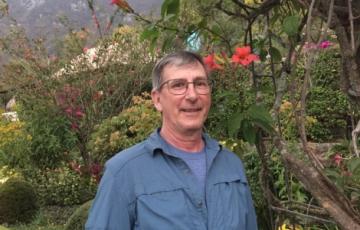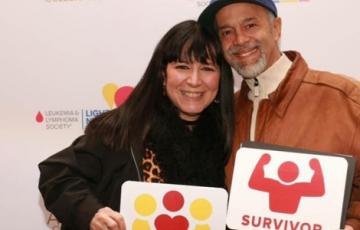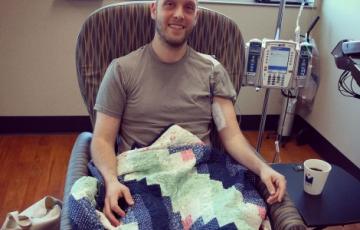Search Results

Stephen
Here's a truly inspiring story about a lymphoma patient and his treating physician who discovered in the midst of treatments last year that they shared a bond as former national champion ballroom dancers – and how the special connection affected his care.

Holly
In February 2024, I had just entered my second trimester of pregnancy and woke up with a swollen lymph node on my neck about the size of a golf ball. After scans and two biopsies, I was diagnosed with diffuse large B-cell non-Hodgkin lymphoma (DLBCL). It was found to be high-grade (meaning it’s growing fast). This is an aggressive form of lymphoma, so I immediately began chemotherapy while pregnant. Waiting until after the baby was born for treatment (estimated six months later) was not in my best interest, and unfortunately, the risk of waiting was too high.
Financial and Legal
Balancing WorkThe many responsibilities of caring for someone often leads to job conflicts. Work is a financial necessity and a major source of personal satisfaction, but for many caregivers, it is often difficult to balance the twin responsibilities of caregiving and working. Each caregiver’s working conditions are different. Talk to your supervisor and look in the employee handbook or other human resources publications to learn about your company’s policy on caregivers.

Daniel (Lil Sicky)
Cancel blood cancer with web3! Daniel is a 27-year-old lymphoma patient who combined his medical diagnosis and love of digital art into an NFT project supporting The Leukemia & Lymphoma (LLS) patients and their families.
In November 2021, Daniel was diagnosed with stage three nodular sclerosing Hodgkin lymphoma (NSHL). Like so many others during the COVID-19 pandemic, he has been isolated to protect his health and has been unable to work.
Holly
I noticed a bulge on my lower abdomen in December 2022. I had a negative ultrasound and CT. What was initially believed to possibly be a lipoma (benign tumor of fat) was later biopsied, and by May 2023, I was diagnosed with subcutaneous panniculitis-like T-cell lymphoma (SPTCL). It was a rare form of cutaneous lymphoma. I was young, active, and healthy, so I thought.

Pam
Pam Katten died on September 24, 2002 after a year-long battle with acute myeloid leukemia (AML).

Angela
I am a two-time Hodgkin lymphoma (HL) cancer survivor. I was first diagnosed with stage 2 HL in 2006. I underwent chemo and radiation. The doctors at my check-ups were no longer looking for cancer but looking for the effects the treatment had on me. Well, eight years later it came back aggressively as stage 4 HL in my lung. I went to Dr. Armitage at Nebraska Medicine and underwent a stem cell transplant using brentuximab vedotin, a target therapy drug that was successful. He is a worldwide expert on lymphoma, so I knew I was in good hands.
Samantha
In February 2023, I was on top of the world. I turned 27 years old, I was training for a new position at my dream company, I spent an amazing weekend in Nashville with girlfriends, and had just touched down from Mexico after spending a fantastic weekend with one of my best friends. Everything felt right ― for the most part. While this month was filled with love, laughter, and good times, it was also filled with night sweats, stomach pains, and overall feelings of illness.
Follow-Up Care
Follow-up care is important with both aggressive and indolent forms of NHL because if the disease recurs, curative options are still available for many people. Follow-up care needs to be individualized and should be based on several factors, including how the disease initially manifested. Patients who are in remission should continue to be monitored by clinical assessment as determined by their doctor. In the past, computed tomography (CT) scans or other diagnostic imaging were done routinely in an attempt to detect relapse.
Relapsed and Refractory
Most patients with classical HL are cured by their initial (first-line) treatment. However, in a significant percentage of patients—especially those with advanced stage HL—the disease relapses or is refractory.
- Relapse means the disease comes back after a remission following treatment.
- Refractory means the disease has not responded to treatment.
For these patients, HL is still potentially curable.
Prognostic Factors
Prognosis is the likely outcome of a disease along with the chance of recovery or recurrence. Hodgkin lymphoma (HL) cases are generally classified into the three subgroups described below.

Bradley
I was diagnosed with mantle cell lymphoma (MCL) on February 13, 2017. I went to MD Anderson since I was already living in Houston, Texas. I was a pastor and counselor for 24 years. I was able to use my counseling skills with other patients as I was going through my inpatient treatment. I introduced patients to The Leukemia & Lymphoma Society (LLS) and AFLAC, as well as provided a listening ear. My life was not without troubles. My brother took his life the same day as my diagnosis. After my first relapse, my wife of 24 years passed from stomach cancer in May 2019.

Dane
I was diagnosed with stage 3 diffuse large B-cell lymphoma (DLBCL) in the summer before my senior year of high school in 2020. It was a tough adjustment dealing with the treatment and the aftereffects of treatment while going into my final year of high school. A relatively carefree life was upturned in an instant, and I was presented with new challenges of balancing my new condition with the social and educational challenges that the final year of high school posed.
Lo
I was diagnosed with stage 3 Hodgkin lymphoma (HL) in February 2022. I endured six months of chemotherapy and relied on my girlfriend to be my caregiver. I faced many setbacks including remaining neutropenic for the majority of my treatment. This meant staying home 24/7 despite going to the hospital and spending a lot of time online.

Shar
For the past nine years as a physician assistant, I have had the privilege of taking care of acute leukemia, high-risk lymphoma and bone marrow transplant patients at the Intermountain Blood and Marrow Transplant Program. Throughout my years at this job, I have seen the struggles patients and their families face once they’ve been told “you have cancer.” I've enjoyed being an important part of our patients’ medical team, helping them heal physically and emotionally, but I wanted to do more.

Bruce
I was diagnosed with mantle cell lymphoma in August 2019 at age 64. It was an accidental find while scanning for a kidney stone. I was late stage 3 at diagnosis with no prior symptoms.
I had 4 rounds of R-DHAX finishing at the end of 2019 and followed with an autologous stem cell transplant at the University of Virginia on February 24, 2020. Along the way I had a life threatening duodenal ulcer (Oscar) as a result of the R-DHAX treatment.

Miguel
Miguel was diagnosed with Non-Hodgkin lymphoma in 2017. He was an active, healthy man all his life so this came as a total shock. We didn't know what to expect or what the outcome would be and we were both beyond devastated.
As being inquisitive is my nature, I gathered all the information I could and became extremely proactive in my husband's care and my determination to get him healed from this disease. Giving up was NOT an option for either of us.
Dianne
When I was a little girl, I knew I wanted to be a nurse so I could help people. I did become a registered nurse, predominately in critical care settings. So, when you receive a disease diagnosis, you treat the problem…right? Not necessarily I have learned.
I was recently diagnosed with non-Hodgkin lymphoma (NHL). I felt as if I was tumbling down a dark, hot hole. “Not curable, treatable, lifelong”. This is “watch and wait” protocol diagnosis…an overwhelming concept…”watch and worry”, I was told, was another concept.

Christian
In March 2017, I was diagnosed with Hodgkin's Lymphoma.
This came as a huge shock. I immediately starting thinking about how this might impact my wife and our two young daughters' lives.
I had 2.5 cycles of ABVD and ISRT radiotherapy and have been in remission since August 2017. I couldn't have down it without the support of my family, friends, LLS.org support groups and even the ice hockey team I had to stop playing with, who sported violet stick and shin guard colored tape when playing the rest of the season.

Shelley
Shelley was diagnosed with B-cell lymphoma in September of 2010 after finding a lump behind her ear. Testing showed she was in stage 3 and had a tumor in her large intestine. Her doctors went before the tumor board, where several other medical experts reviewed her options, to determine whether she should have surgery or chemotherapy. Approximately two weeks later she ended up having emergency open colon surgery and surgeons found another tumor blocking her small intestine.

Kimberly
My wife was in the thick of her emergency medicine residency when life threw us a curveball — she was unexpectedly diagnosed with Hodgkin lymphoma (HL). In the middle of 24-hour shifts, parenting our three-year-old, and studying for boards, she now had to face chemotherapy too.

Becky
In 2019, I was diagnosed with T-cell lymphoma (TCL). In 2021, I had a stem cell transplant. As of November 23, 2023, I am cancer-free.

Grace
On February 6, 2023, I was diagnosed with stage 3 Hodgkin lymphoma (HL). However, my story starts months before that. I was attending my sophomore year of college at my university when I started experiencing symptoms I did not understand or put together. I started experiencing extreme exhaustion, I was dropping weight very fast, and I was always lightheaded. I decided to come home only three weeks into my spring semester because I couldn’t keep up my course load with how bad I was feeling.